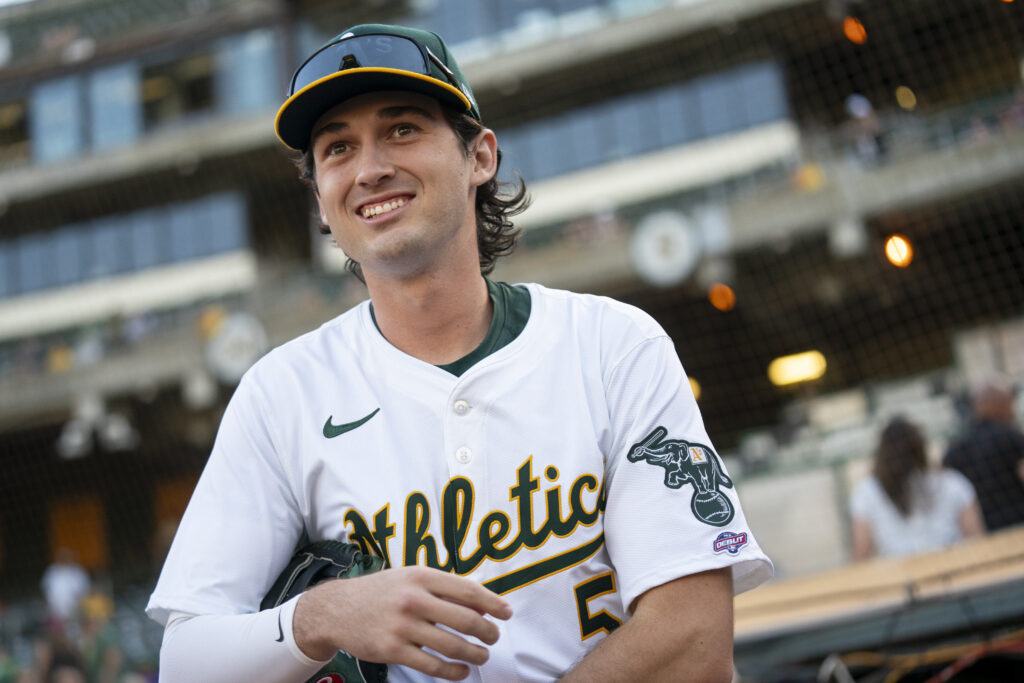
When the Athletics began to properly invest in the franchise for the first time in years this offseason, putting together their largest Opening Day payroll since 2021 and highest payroll for luxury tax purposes in franchise history, it came with an understanding that the additions of players like Luis Severino and Jeffrey Springs would not be enough to propel the club to contention in a crowded AL West division without substantial steps forward from young talent already within the organization.
Fortunately for the A’s, that’s exactly what has happened. The club’s first season in West Sacramento is going quite well, with a 20-18 record that places them second in the AL West even after they dropped their latest series to the division-leading Mariners. With the division’s recent top dogs in Houston and Arlington now both struggling to stay above .500, the A’s have been able to fight their way into contention thanks in large part to excellent performances from recent first-round picks Jacob Wilson and Tyler Soderstrom. Wilson, in particular, is an interesting player to consider after he rattled off a 15-game hit streak to open the season. During that time, he hit .368/.368/.544 across 57 plate appearances.
It’s an impressive slash line, to be sure, but his .358 BABIP during that time did not exactly appear sustainable, especially when he had not drawn a single walk during that stretch. Of course, looking at sample sizes of less than 60 plate appearances comes with far too much noise to be all that valuable when discussing balls in play. Wilson took the 150th plate appearance of the season yesterday, providing a slightly larger body of work to examine. Overall, he’s hitting .357/.383/.476 with a wRC+ of 148. He’s walking just 4.0% of the time, and hardly striking out more than that (4.7%). His .361 BABIP is well outside of the typically expected range, and his 2.2% barrel rate shows that he won’t be hitting for much power any time soon; if anything, he’s hitting for more power now (.119 ISO) than expected based on his batted ball results.
All of that suggests that Wilson is extremely unlikely to keep up his current level of production, but that shouldn’t be taken as a suggestion that he’s guaranteed to revert to the 86 wRC+ he posted in 28 games last year. There are two notable hitters who have found great success in the majors in recent years with a similar approach to Wilson at the plate: Luis Arraez and Steven Kwan. Of course, there’s also plenty of players like Nick Madrigal and Billy Hamilton who fail to find success in the majors due to their lack of power. The question remains: has Wilson shown enough similarities to players like Kwan and Arraez that he can be counted on for sustained success as an above-average MLB hitter?
It’s hard to come up with a more straightforward comp for Wilson than Arraez. After all, one need look no further than Arraez’s 2023 season with the Marlins to find a nearly mirror image of what Wilson has done so far in 2025. In 147 games with the Marlins that year, Arraez hit an excellent .354/.393/.469 with a wRC+ of 130. He struck out in 5.5% of his at-bats while walking 5.7% of the time, and his ISO sat at just .115 while he floated a .362 BABIP. Arraez accomplished this feat thanks primarily to his line drive rate, which sat at an MLB-best 28.5%. Hitting the ball on a line that often is a nearly surefire way to rack up a lot of hits. Another key factor is Arraez’s relatively small amount of fly balls; just 28.7% of his batted balls were hit in the air that year, a bottom-ten figure in the sport. That puts obvious limitations on a player’s home run power, but it’s great news for a player’s batting average.
Of course, it should be remembered that Arraez is something of a unicorn. Attempting to replicate his approach leaves a player very prone to year-to-year swings in productivity, as seen by the fact that Arraez himself has stuck with that approach in 2024 and ’25 but seen his wRC+ drop to just 109 in that time due to a 48-point drop in BABIP. Some of that can be explained by a small dip in line drive rate (26.3%), but much of it comes down to the randomness involved with batted balls that aren’t hit especially hard. Perhaps Kwan’s approach, which involves more patience (39.4% career swing rate) than either Arraez (46.0%) or Wilson (51.8%), could be an option for Wilson if replicating Arraez doesn’t work out. But for now, Wilson’s Arraez-esque approach does seem to be working for him. His 23.7% line-drive rate is hardly the best in the league right now, but it’s still a well above-average figure. And his ability to limit soft contact is very similar to Arraez; 16.8% of Wilson’s batted balls have been hit softly this year, as compared to 15.2% of Arraez’s last season.
How do MLBTR readers view Wilson’s future? Will he be able to emerge as a rare unicorn able to get by on pure contact like Arraez, or will he need to make adjustments to be more patient at the plate like Kwan in order to be an above-average hitter? Have your say in the poll below:
This post was originally published on this site be sure to check out more of their content.


